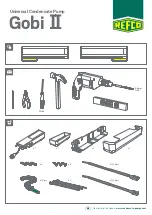
En-3
3. INSTALLATION WORK
3.1. Selecting an installation location
Correct initial installation location is important because it is difficult to move unit after it is
installed.
WARNING
Select installation locations that can properly support the weight of the indoor. Install the
units securely so that they do not topple or fall.
CAUTION
Do not install the unit in the following areas:
•
Area with high salt content, such as at the seaside.
It will deteriorate metal parts, causing the parts to fail or the unit to leak water.
•
Area filled with mineral oil or containing a large amount of splashed oil or steam, such
as a kitchen.
It will deteriorate plastic parts, causing the parts to fail or the unit to leak water.
•
Area that generates substances that adversely affect the equipment, such as sulfuric
gas, chlorine gas, acid, or alkali.
It will cause the copper pipes and brazed joints to corrode, which can cause refrigerant
leakage.
•
Area that can cause combustible gas to leak, contains suspended carbon fibers or
flammable dust, or volatile flammables such as paint thinner or gasoline.
If gas leaks and settles around the unit, it can cause a fire.
•
Area where animals may urinate on the unit or ammonia may be generated.
Do not use the unit for special purposes, such as storing food, raising animals, growing
plants, or preserving precision devices or art objects.
It can degrade the quality of the preserved or stored objects.
Do not install where there is the danger of combustible gas leakage.
Do not install the unit near a source of heat, steam, or flammable gas.
Install the unit where drainage does not cause any trouble.
Install the indoor unit, power supply cable, transmission cable, and remote controller
cable at least 40 in (1 m) away from a television or radio receivers. The purpose of this is
to prevent TV reception interference or radio noise.
(Even if they are installed more than 40 in (1 m) apart, you could still receive noise under
some signal conditions.)
If children under 10 years old may approach the unit, take preventive measures so that
they cannot reach the unit.
Decide the mounting position with the customer as follows:
(1) Install the indoor unit on a place having a sufficient strength so that it withstands
against the weight of the indoor unit.
(2) The inlet and outlet ports should not be obstructed; the air should be able to blow all
over the room.
(3) Leave the space required to service the air conditioner.
(4) A place from where the air can be distributed evenly throughout the room by the unit.
(5) Install the unit where connection to the outdoor unit (or RB unit) is easy.
(6) Install the unit where the connection pipe can be easily installed.
(7) Install the unit where the drain pipe can be easily installed.
(8) Install the unit where noise and vibrations are not amplified.
(9) Take servicing, etc., into consideration and leave the spaces. Also install the unit
where the filter can be removed.
3.2. Installation dimensions (ceiling concealed type)
Provide a service access for inspection purposes.
Do not place any wiring or illumination in the service space, as they will impede service.
Installation Dimensions
Left
side
Strong and durable ceiling
Indoor unit
Right
side
6 (150) or more
16 (400) or more
Service access
Ceiling
Unit: in (mm)
99 (2500) or more
(when no ceiling)
Floor
10 (240) or more
1 (20) or more
12 (300) or more
1 (20) or more
Adjust the wind direction in the room depending on the shape of blow out opening.
Service access
Air
Air
16 (400)
or more
4 (100) or more
12 (300) or more
Indoor unit
[Top view]
Service space
Unit: in (mm)
3.3. Installation dimensions (wall mounted type/floor
standing concealed type)
The wall mounted type/floor standing concealed type requires a temperature correction
setting. Perform this in “7. FIELD SETTING”.
Strong and
durable floor
1 (10) or less
Left side
6 (150)
or more
6 (150)
or more
6 (150)
or more
1 (20)
or more
1 (20)
or more
Unit: in (mm)
16 (400)
or more
Inlet air
Strong and
durable floor
1 (10) or less
Right side
(PIPE side)
Grille
Left side
6 (150)
or more
6 (150)
or more
6 (150)
or more
1 (20)
or more
1 (20)
or more
Unit: in (mm)
16 (400)
or more
Inlet air
Strong and
durable floor
Right side
(PIPE side)
Duct
Grille
Strong and
durable floor
9374342556-02_IM.indb 3
27-Sep-19 10:29:34 AM




































